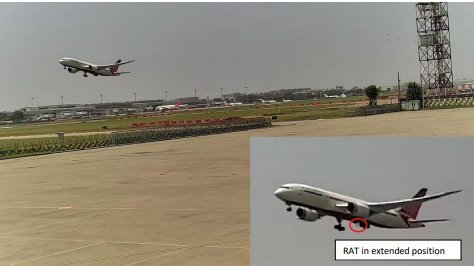The AAIB’s early findings show that both engines of the Boeing 787-8 Dreamliner transitioned to cutoff mode within a second of each other, shortly after the aircraft reached 180 knots.
BY PC Bureau
New Delhi
July 13, 2025 — The Aircraft Accident Investigation Bureau (AAIB) released its preliminary report early Saturday on the crash of Air India flight AI171, which went down moments after takeoff from Ahmedabad on June 12, killing at least 270 people.
The 15-page report sheds light on a catastrophic twin-engine failure that occurred just seconds after the Boeing 787-8 Dreamliner lifted off from Runway 23. Bound for London Gatwick with 230 passengers and crew onboard, the aircraft failed to gain altitude and crashed just outside the airport perimeter.
Engines Cut Off Seconds After Takeoff
According to the AAIB, the aircraft achieved a top speed of 180 knots at 08:08:42 UTC. Immediately afterward, both engine fuel cutoff switches — for Engine 1 and Engine 2 — transitioned from “RUN” to “CUTOFF” within a second of each other, effectively shutting down the engines. There is no indication that either pilot initiated the shutdown.
READ: The Mega Tribal Land Grab (2): How Adivasi Fight a Losing battle in Chhattisgarh
“Engine N1 and N2 values began to drop rapidly from their takeoff settings as fuel flow was terminated,” the report noted. By 08:08:47 UTC, the N2 speeds had fallen below the minimum idle threshold, prompting automatic deployment of the Ram Air Turbine (RAT), a backup power system.
Cockpit Voice Recorder Captures Confusion
The Cockpit Voice Recorder (CVR) revealed a brief but critical exchange between the pilots. One is heard asking, “Why did you cutoff?” to which the other replies, “I didn’t do so.” Seconds later, the RAT deployed automatically, suggesting complete engine power loss.
CCTV footage from the airport confirmed that the RAT was deployed during the aircraft’s initial climb, further corroborating the loss of engine thrust. The aircraft began losing altitude immediately after becoming airborne and crashed before it could clear the perimeter wall.
Previous Defect, Cleared for Flight
Earlier that day, the same aircraft had arrived from Delhi as AI423. A stabilizer position sensor defect (“STAB POS XDCR”) had been logged by the previous crew. According to the report, an on-duty Air India maintenance engineer conducted troubleshooting and cleared the aircraft for the onward flight to London.
Automatic Restart Attempted
Flight data indicates that at 08:08:52 UTC, the fuel cutoff switch for Engine 1 was manually returned to the “RUN” position. The APU (Auxiliary Power Unit) inlet door opened shortly after, consistent with automatic engine restart logic. Two seconds later, the Engine 2 switch was also moved back to “RUN.” However, by then, the aircraft had lost critical altitude.
BREAKING ⚠️
AI171 preliminary crash report out: Both engines shut down seconds after takeoff. Pilots denied cutting fuel. RAT deployed, thrust levers idle, engines failed to relight. Crashed in 32 secs. Fuel clean. Known fuel switch flaw not inspected. https://t.co/zfR7EkYVJa pic.twitter.com/g1OqEWgEqA
— Shiv Aroor (@ShivAroor) July 11, 2025
No Bird Strike Evidence
Investigators confirmed that no significant bird activity was recorded along the flight path. The cause of the twin-engine cutoff remains under investigation, as neither pilot acknowledged triggering the shutdown.
The final report will hinge on deeper analysis of flight systems, cockpit inputs, and potential electrical or software faults in the aircraft’s control logic. The AAIB has urged caution in drawing early conclusions.
READ: Iran Strike Damages U.S. Base, Satellite Images Reveal
The crash is one of India’s worst aviation disasters in recent years. Recovery and identification of remains continue, as investigators work to piece together the exact sequence that led to the catastrophic failure.
KEY FINDINGS:
- Both engines shut down seconds after takeoff.
- Pilots did NOT cut fuel—CVR confirms one asked, “Why did you cut off?” The other replied, “I didn’t.” Fuel control switches mysteriously moved to CUTOFF, one after the other. RAT (Ram Air Turbine) deployed mid-air—indicating total power loss.
- Engines failed to relight properly despite FADEC auto-sequence. \Aircraft crashed within 32 seconds of takeoff, hitting a medical college hostel.
- Fuel was clean; no contamination found in samples.
- FAA had warned in 2018 of a design flaw in fuel control switches—but it was never inspected, as the advisory wasn’t mandatory.
- Ministry @MoCA_GoI confirms: No evidence of bird strike, weather was clear, and takeoff weight was within limits.













